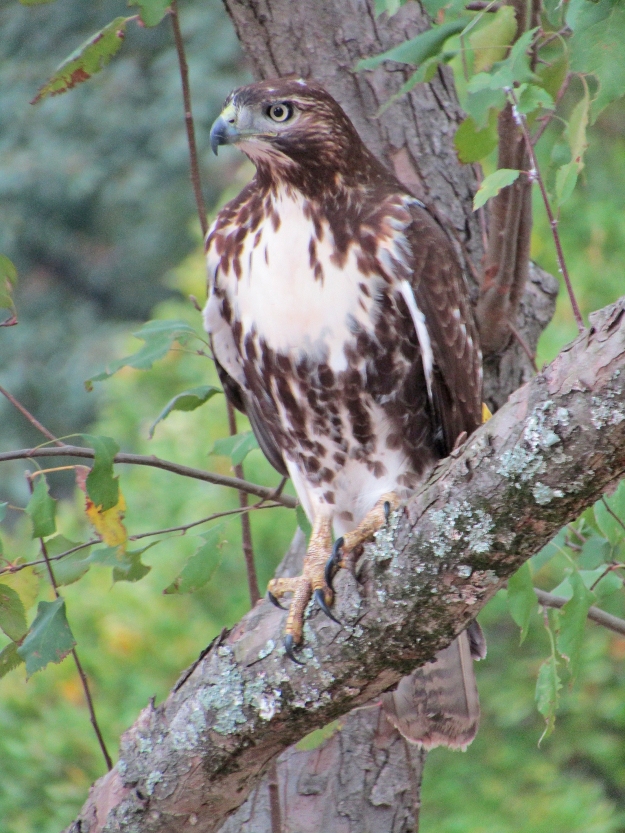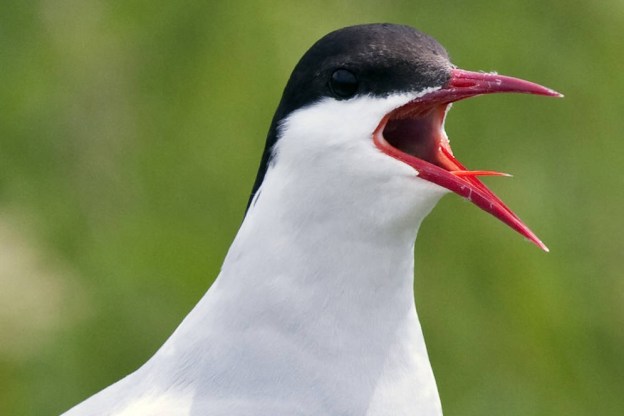 Photo by Dianna Lynne • Leaping onto a fully stocked feeder, an Eastern gray squirrel scatters seeds in all directions. The unconquerable squirrel is one of the most unwanted guests at many bird-feeding stations.
Photo by Dianna Lynne • Leaping onto a fully stocked feeder, an Eastern gray squirrel scatters seeds in all directions. The unconquerable squirrel is one of the most unwanted guests at many bird-feeding stations.
The winter bird-feeding season is coming to a close, but there’s no need to pull the welcome mat completely. Some of our summer visitors appreciate some supplemental food. Of course, there’s less need for our offerings during warm weather when insects and other food sources are readily available.
People in Great Britain spend 200 million pounds per year on wild bird food. In the United States, people are spending $4 billion each year on feed for the birds. Another $800 million in spending goes to feeders, bird baths and other accessories used to attract wild birds.
People have been feeding birds in the United States of America since before it was a nation. The father of our country, George Washington, fed wild birds at his home, Mount Vernon. The great writer and thinker Henry David Thoreau fed the birds and learned to identify many of the birds around Walden Pond in Massachusetts. Poet Emily Dickinson tossed crumbs to sparrows and then turned those special moments with her feathered friends into poetry.
Since the time of Washington, Thoreau and Dickinson, if not before, Americans have been supplying food, as well as shelter and water, to persuade birds to bring themselves closer. In return, we enjoy their color, their interesting behavior, their songs, and much more.
I continue feeding during the warmer months, although I do cut back on the quantity of my offerings. One of the best bonuses for engaging in year-round bird feeding is the chance to see parent birds bring their offspring to feeders to introduce them to human-offered fare. Be aware, however, that when you put out a table offering free food, you’re bound to attract some unexpected guests. Sometimes those unanticipated visitors can wreak havoc on the smooth management of a feeding station for your birds.
Here is my version of the Top 5 candidates for a “Not Welcome” list of the wildlife most people would prefer not to entertain at their feeders.
Hawks
The raptors are, of course, birds themselves. Therein rests the irony. Flocks of birds active around feeders are like ringing a dinner bell for some raptors, which have learned that songbirds in such situations on occasion make easy pickings.
It’s not any single raptor that can be identified as the most obvious threat to songbirds. Species such as American kestrel, sharp-shinned hawk, Cooper’s hawk, red-shouldered hawk, merlin, peregrine falcon and red-tailed hawk will prey on their fellow birds if given ample opportunity.

Photo by Bryan Stevens • Raptors, like this red-tailed hawk, can cause concern when they take up residence near a feeder in a yard or garden.
If a hawk does begin to show interest in your feeders, it may be necessary to curtail or even cease feeding songbirds until after the raptor loses interest and moves on to other hunting grounds.
I hesitate to even place raptors on this list because I believe that every bird is a wonderful creation. It’s best to remember that hawks view smaller birds flocking to a feeder in the same way those small songbirds view the abundance of seeds. For both hawks and songbirds, our offerings represent easy meals. It’s not easy, but the best choice is to co-exist — if not at peace, then at terms with nature’s reality.
Opossums
The Virginia opossum, also known as the North American opossum, or simply “possum,” is often overlooked because its raids on feeders take place after dark. Although the opossum has 50 teeth (that’s more than any other North American mammal has) in its jaws, it shares the night with other active omnivores, including bears and raccoons.
Regardless of its toothy grin, the possum is not adept as hulling sunflower seeds. The telltale sign that a possum is raiding your feeders involves the discovery of little piles of pulped sunflower seeds, hull and all, in your feeder or on the ground beneath it. The possum pulverizes the sunflower seed and evidently tries to extract what nutritional content it can. Of course, suet, nuts and other feeder fare are on the possum’s menu.
This particular possum is the only marsupial found north of Mexico. The continent of Australia is more famous for its marsupials, which include kangaroos, wallabies and wombats.
Raccoons
These masked, ring-tailed bandits are the bane of many a person who enjoys feeding birds. While they primarily restrict their raids to the hours between sunset and dawn, some emboldened raccoons will occasionally become brazen enough to stake a claim to feeders in broad daylight. A couple of years ago, a trio of young raccoons arrived early in the evening with plenty of daylight remaining to feed in the feeders while I watched from a nearby lawn chair with my binoculars.
Raccoons will also spirit away feeders. I’ve found hummingbird feeders, suet feeders and small plastic feeders carried a good distance into the woods before the thieving raccoon dropped them. The stolen items are usually damaged but, on occasion, I’ve recovered some of my items that were more or less no worse for the wear.
On one occasion, a crafty raccoon managed to remove a sunflower seed feeder from its branch on a tree outside one of my windows, I later found the portly critter reclining lazily on his back wedged between the trunk and a branch high on a nearby tree, holding the feeder in one arm and reaching into it with the other like a person eating popcorn.
Raccoons are highly intelligent and inquisitive, which only makes them more difficult to discourage from raiding feeders. They can be amusing and entertaining in their own right, but it’s best not to encourage their visits. If they prove too persistent, cease feeding birds until the raccoons have moved to a new location.

Photo by Bryan Stevens • Curious and intelligent, raccoons can think of many ways of ransacking a feeding station meant for birds.
Bears
A visit from a black bear is hard to miss. With their brute strength, bears are capable of mangling and destroying even the most sturdily constructed of bird feeders. While there are many other unwanted feeder guests, none can match the bear for its sheer capacity for destruction. Black bears can weigh between 200 to 600 pounds, so it’s not hard to imagine their potential for wreaking havoc.
Amanda Austwick lives in Flag Pond, Tennessee. She is a dedicated feeder of our feathered friends, which has led to repeated incidents with problem bears over the years. Amanda lives within the official boundaries of the Cherokee National Forest. Black bears have been thriving in the Cherokee National Forest, as well as throughout the southeastern United States.
When I first corresponded with Amanda several years ago, she was writing to me about a bear attack on her feeders. “One feeder was completely bent over on the ground,” she wrote. I also pointed out that the bear is actually just feeding on the seed. The damage to the feeder is a by-product caused by the fact bears probably don’t know their own strength.
I’ve not gone completely unscathed when it comes to bears and my feeders. Several years ago I owned a nice feeder with a metal meshwork used for holding shelled peanuts, which are loved by birds such as chickadees, titmice, nuthatches and woodpeckers. I woke one morning to find the feeder had been mangled into the equivalent shape of a pretzel.
Compared to the stories told by Amanda, as well as other people who have shared their own bear tales over the years, I got off lucky to only lose a single feeder to a bear. Brookie and Jean Potter, friends who live near Wilbur Lake in Carter County, Tennessee, have had to innovate to stay one step ahead of the bears living in proximity to them. Brookie managed to raise their feeders beyond a bear’s reach using a complicated system of poles and pulleys.
If such proactive measures are not something one wishes to do, there’s one simple step that can be taken. People can bring in their feeders at night to ensure there’s nothing left outdoors to attract the attention of a meandering bear. Bears are omnivores, eating a varied diet ranging from insects and fish to amphibians and bird eggs. When a bear finds a bird feeder, they’re happy to include sunflower seeds or other such fare in their diet. When such food is no longer available, they’re likely to move on.

Photo Courtesy of Amanda Austwick • This bear caused considerable damage to the Austwick feeders.
Squirrels
They may not match a black bear for sheer destructive capability, but I regard the Eastern gray squirrel as Public Enemy Number One when it comes to having peace and tranquility at a bird-feeding station. What justifies this ranking? It’s simple, really. I know of no sure-fire way to deny a hungry and determined squirrel access to any type of feeder. It’s possible to slow them down, but I think the best we can do is maintain an uneasy truce of co-existence with squirrels.
I wouldn’t begrudge the squirrels some bird seed if they didn’t show such ingratitude by gnawing on feeders. With their sharp incisors, squirrels can chew up and spit out plastic and even wood feeders. More expensive feeders made of ceramics, metal and glass are immune to the same type of squirrel vandalism.
Although I’ve not tried it, I’ve heard that sunflower seed laced with capsaicin will deter squirrels. This spicy substance is even used to deter such large mammals as elephants and grizzly bears. Capsaicin, which is derived from hot peppers, reacts entirely differently with birds. While many mammals will avoid food containing even minute amounts of capsaicin, birds will readily consume it. The difference seems to be that bird receptor cells are largely insensitive to capsaicin.

Photo by Pixabay on Pexels.com • The gray squirrel is a cunning and often destructive guest at feeders intended for the benefit of birds.
••••••
To be sure, I could have added some other wildlife species to the list. White-tailed deer can graze on flowers planted for the benefit of hummingbirds. Deer have even been documented eating the eggs of songbirds, perhaps more for the calcium shell than any other reason. Chipmunks are almost as wily as squirrels, but they’re cuter and non-destructive. Insects, such as bees and hornets, can overwhelm sugar water feeders intended for hummingbirds.
Don’t even get me started on stray cats! A few years back, a study by researchers from the Smithsonian’s Migratory Bird Center and the U.S. Fish and Wildlife Center found that between 1.4 to 3.7 billion birds lose their lives to cats each year in the United States. In addition to birds, cats kill billions of small mammals — shrews, voles, mice, rabbits — every year. Most of the carnage is committed by feral or stray cats, not house cats. My own two cats are kept indoors to avoid contributing to the problem.



































